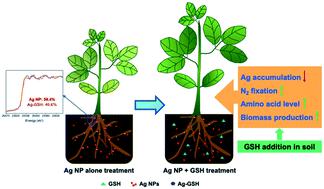当前位置:
X-MOL 学术
›
Environ. Sci.: Nano
›
论文详情
Our official English website, www.x-mol.net, welcomes your
feedback! (Note: you will need to create a separate account there.)
Dual roles of glutathione in silver nanoparticle detoxification and enhancement of nitrogen assimilation in soybean (Glycine max (L.) Merrill)
Environmental Science: Nano ( IF 5.8 ) Pub Date : 2020-05-13 , DOI: 10.1039/d0en00147c Chuanxin Ma 1, 2, 3, 4, 5 , Hong Liu 6, 7, 8, 9 , Guangcai Chen 9, 10, 11, 12 , Qing Zhao 9, 13, 14, 15 , Huiyuan Guo 1, 2, 3, 4 , Rakesh Minocha 4, 16, 17, 18 , Stephanie Long 4, 16, 17, 18 , Yuanzhi Tang 4, 19, 20, 21 , Emily M. Saad 4, 19, 20, 21 , Roberto DeLaTorreRoche 4, 5, 22, 23 , Jason C. White 4, 5, 22, 23 , Baoshan Xing 1, 2, 3, 4 , Om Parkash Dhankher 1, 2, 3, 4
Environmental Science: Nano ( IF 5.8 ) Pub Date : 2020-05-13 , DOI: 10.1039/d0en00147c Chuanxin Ma 1, 2, 3, 4, 5 , Hong Liu 6, 7, 8, 9 , Guangcai Chen 9, 10, 11, 12 , Qing Zhao 9, 13, 14, 15 , Huiyuan Guo 1, 2, 3, 4 , Rakesh Minocha 4, 16, 17, 18 , Stephanie Long 4, 16, 17, 18 , Yuanzhi Tang 4, 19, 20, 21 , Emily M. Saad 4, 19, 20, 21 , Roberto DeLaTorreRoche 4, 5, 22, 23 , Jason C. White 4, 5, 22, 23 , Baoshan Xing 1, 2, 3, 4 , Om Parkash Dhankher 1, 2, 3, 4
Affiliation

|
Widespread use of silver nanoparticles (Ag NPs) as pesticides and fungicides in agriculture is a major environmental concern. In the present study, soybean (Glycine max L.) was grown in Ag NP (0–62.5 mg kg−1)-amended soil with or without the addition of glutathione (GSH). Ag NPs exerted severe phytotoxicity and caused the reduction of shoot and root biomass and total number of nodules or completely inhibited nodule formation at doses above 31.25 mg kg−1. Synchrotron-based techniques were applied to analyze Ag speciation in both the soil and the soybean root tissues at harvest. The results indicate that the majority of Ag remained in the form of Ag NPs and that 23% was present as Ag2S in soil; in both root and nodule tissues, Ag–GSH was the main component (40.6–88%) other than Ag NPs (12–59.4%), highlighting the important role of GSH in alleviating the Ag NP-induced toxicity. The addition of 0.8 mM GSH not only significantly increased fresh biomass by 85% in the 62.5 mg kg−1 Ag NP treatment but also decreased Ag accumulation by 24.8–27% in soybean tissues. Although the addition of 0.8 mM GSH reduced the nodule number and weight as compared to the control, the total nitrogen content in soybean co-treated with Ag NP and GSH was more than 5-fold higher than that in the Ag NP alone treatments, suggesting that GSH may be utilized as a nitrogen source while simultaneously alleviating Ag NP toxicity. The shoot and root contents of thiol compounds (cysteine and gamma-glutamylcysteine) in the GSH treatments were several folds higher than that in the control and Ag NP alone treatments. Further, higher levels of essential amino acids, particularly alanine, glutamate, and glutamine which play important role in N assimilation in plants, in soybean across all the treatments further confirmed that GSH was utilized as a nitrogen source, resulting in enhanced soybean growth. Taken together, this study clearly demonstrated the negative impact of Ag NPs on soybean productivity and N fixation and highlights the protective role of GSH against Ag NP-induced toxicity. These findings have significant relevance for developing future strategies to minimize crop loss in marginal or contaminated soils, subsequently enhancing global food security.
中文翻译:

谷胱甘肽在银纳米颗粒解毒和增强大豆中氮同化中的双重作用(Glycine max(L.)Merrill)
银纳米颗粒(Ag NPs)在农业中广泛用作农药和杀真菌剂是一个主要的环境问题。在本研究中,大豆(Glycine max L.)在添加或不添加谷胱甘肽(GSH)的Ag NP(0-62.5 mg kg -1)改良土壤中生长。在大于31.25 mg kg -1的剂量下,Ag NPs具有严重的植物毒性,并导致枝条和根生物量的减少以及根瘤总数或完全抑制根瘤形成。基于同步加速器的技术用于分析收获时土壤和大豆根部组织中的银形态。结果表明,大部分的Ag以Ag NP的形式保留,并且23%的Ag 2存在土壤中的硫;在根和根瘤组织中,Ag–GSH是除Ag NPs(12–59.4%)以外的主要成分(40.6–88%),突显了GSH在减轻Ag NP诱导的毒性中的重要作用。添加0.8 mM GSH不仅使62.5 mg kg -1中的新鲜生物量显着增加了85%Ag NP处理后,大豆组织中的Ag积累量减少了24.8–27%。尽管与对照相比,添加0.8 mM GSH减少了结节数量和重量,但与Ag NP和GSH共同处理的大豆中总氮含量比单独的Ag NP处理高5倍以上,这表明GSH可以用作氮源,同时减轻Ag NP的毒性。在GSH处理中,硫醇化合物(半胱氨酸和γ-谷氨酰胺基半胱氨酸)的茎和根含量比单独的对照和Ag NP处理高出几倍。此外,较高水平的必需氨基酸,尤其是丙氨酸,谷氨酸和谷氨酰胺,在植物的N同化中起重要作用,大豆在所有处理中的含量进一步证实了谷胱甘肽被用作氮源,从而促进了大豆的生长。两者合计,这项研究清楚地表明了银纳米颗粒对大豆生产力和固氮的负面影响,并强调了谷胱甘肽对银纳米颗粒诱导的毒性的保护作用。这些发现与制定未来战略以最大程度地减少边缘或受污染土壤中的农作物损失,从而增强全球粮食安全具有重大意义。
更新日期:2020-07-16
中文翻译:

谷胱甘肽在银纳米颗粒解毒和增强大豆中氮同化中的双重作用(Glycine max(L.)Merrill)
银纳米颗粒(Ag NPs)在农业中广泛用作农药和杀真菌剂是一个主要的环境问题。在本研究中,大豆(Glycine max L.)在添加或不添加谷胱甘肽(GSH)的Ag NP(0-62.5 mg kg -1)改良土壤中生长。在大于31.25 mg kg -1的剂量下,Ag NPs具有严重的植物毒性,并导致枝条和根生物量的减少以及根瘤总数或完全抑制根瘤形成。基于同步加速器的技术用于分析收获时土壤和大豆根部组织中的银形态。结果表明,大部分的Ag以Ag NP的形式保留,并且23%的Ag 2存在土壤中的硫;在根和根瘤组织中,Ag–GSH是除Ag NPs(12–59.4%)以外的主要成分(40.6–88%),突显了GSH在减轻Ag NP诱导的毒性中的重要作用。添加0.8 mM GSH不仅使62.5 mg kg -1中的新鲜生物量显着增加了85%Ag NP处理后,大豆组织中的Ag积累量减少了24.8–27%。尽管与对照相比,添加0.8 mM GSH减少了结节数量和重量,但与Ag NP和GSH共同处理的大豆中总氮含量比单独的Ag NP处理高5倍以上,这表明GSH可以用作氮源,同时减轻Ag NP的毒性。在GSH处理中,硫醇化合物(半胱氨酸和γ-谷氨酰胺基半胱氨酸)的茎和根含量比单独的对照和Ag NP处理高出几倍。此外,较高水平的必需氨基酸,尤其是丙氨酸,谷氨酸和谷氨酰胺,在植物的N同化中起重要作用,大豆在所有处理中的含量进一步证实了谷胱甘肽被用作氮源,从而促进了大豆的生长。两者合计,这项研究清楚地表明了银纳米颗粒对大豆生产力和固氮的负面影响,并强调了谷胱甘肽对银纳米颗粒诱导的毒性的保护作用。这些发现与制定未来战略以最大程度地减少边缘或受污染土壤中的农作物损失,从而增强全球粮食安全具有重大意义。











































 京公网安备 11010802027423号
京公网安备 11010802027423号